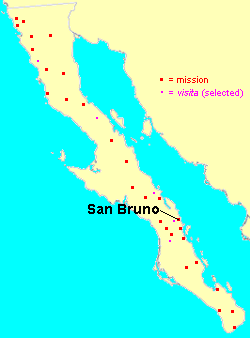
Misión San Bruno
Encyclopedia

The short-lived Jesuit mission of San Bruno was established in 1683 on the Gulf of California
Gulf of California
The Gulf of California is a body of water that separates the Baja California Peninsula from the Mexican mainland...
of Baja California Sur
Baja California Sur
Baja California Sur , is one of the 31 states which, with the Federal District, comprise the 32 Federal Entities of Mexico. Before becoming a state on October 8, 1974, the area was known as the South Territory of Baja California. It has an area of , or 3.57% of the land mass of Mexico and comprises...
, about 20 kilometers north of the later site of the town of Loreto
Loreto, Baja California Sur
Loreto was the first Spanish settlement on the Baja California Peninsula. It served as the capital of Las Californias from 1697 to 1777, and is the current seat of the municipality of Loreto in the Mexican state of Baja California Sur...
.
In 1683, the Spanish admiral Isidro de Atondo y Antillón
Isidoro de Atondo y Antillon
The Spanish admiral Isidro de Atondo y Antillón is best known for his role in unsuccessful attempts to establish colonies on the Baja California peninsula in 1683–1865....
and the Jesuit missionary Eusebio Francisco Kino
Eusebio Kino
Eusebio Francisco Kino S.J. was an Italian Roman Catholic priest who became famous in what is now northwestern Mexico and the southwestern United States in the region then known as the Pimaria Alta...
were forced to abandon an attempted settlement at La Paz because of hostilities with the native Pericúes
Pericúes
The Pericú were the aboriginal inhabitants of the Cape Region, the southernmost portion of Baja California Sur, Mexico...
and Guaycura
Guaycura
The Guaycura were a native people of Baja California Sur, Mexico, occupying an area extending south from south of Loreto to Todos Santos. They contested the area around La Paz with the Pericú....
. Moving north to the central portion of the peninsula, they arrived at the Cochimí
Cochimi
The Cochimí are the aboriginal inhabitants of the central part of the Baja California peninsula, from El Rosario in the north to San Javier in the south....
settlement of Teupnon, at mouth of a substantial arroyo on October 7, the Feast of San Bruno. Mission work was begun among the local inhabitants, and exploratory expeditions into the surrounding region were undertaken, including the first land crossing of the peninsula by Europeans. However, the inadequacy of local and imported food supplies and problems of illness forced the abandonment of San Bruno in 1685, leaving Baja California again entirely in native hands until the first permanent Jesuit mission was established at Loreto
Misión de Nuestra Señora de Loreto Conchó
Misión de Nuestra Señora de Loreto Conchó, or Mission Loreto, was founded on October 25, 1697 at the Monqui settlement of Conchó in the present city of Loreto, Baja California Sur, Mexico...
in 1697.
The San Bruno episode is well documented in the letters and reports of Atondo, Kino, and other participants (Bolton 1936; Burrus 1954, 1965; Mathes 1969, 1974). The modern condition of San Bruno's site, containing the remnants of military emplacements, has been described by Edward W. Vernon (2002:1-7).
See also
- San Bruno, Baja California SurSan Bruno, Baja California SurSan Bruno is a populated place at the Gulf of California in Mulegé Municipality in the Mexican state of Baja California Sur. It is located at , about 20 kilometers north of the city of Mulegé. The short-lived Jesuit Misión San Bruno was established there in 1683, and abandoned in 1685...
- Spanish missions in Baja CaliforniaSpanish missions in Baja CaliforniaThe Spanish Missions in Baja California comprise a series of religious outposts established by Spanish Catholic religious orders, the Jesuits, the Franciscans and the Dominicans, between 1683 and 1834 to spread the Christian doctrine among the local natives...

